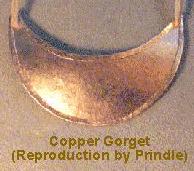
|
|

|
|
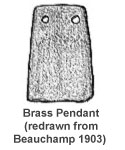
 For Native Americans in the 17th century, metallic ornaments were probably no more popular than those of teeth or bone, becoming more desirable only when natural products were not available, because the animals were no longer easily hunted (Beauchamp 1903). In 1610, Juet (1967) observed Native Americans in New England with various of items of copper worn about the neck. At this time, plain perforated brass disks were worn by Seneca in what is now New York (Wray et. al. 1987). Other small perforated disks of brass were slightly domed and probably attached to clothing (Beauchamp 1903).
For Native Americans in the 17th century, metallic ornaments were probably no more popular than those of teeth or bone, becoming more desirable only when natural products were not available, because the animals were no longer easily hunted (Beauchamp 1903). In 1610, Juet (1967) observed Native Americans in New England with various of items of copper worn about the neck. At this time, plain perforated brass disks were worn by Seneca in what is now New York (Wray et. al. 1987). Other small perforated disks of brass were slightly domed and probably attached to clothing (Beauchamp 1903).
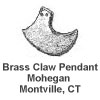 The copper ornament of a Native American child in Middletown or Chatham is described by De Forest (1852) as: "a copper box containing wampum strung on deer leather". This ornament and similar small round sheet metal boxes may have been, or modified from, the 17th century European tobacco snuff boxes (Beauchamp 1902). Another, a handmade Narragansett copper ornament, contained several tiny quartz pebbles resembled a tiny 'rattle' (Simmons 1970).
The copper ornament of a Native American child in Middletown or Chatham is described by De Forest (1852) as: "a copper box containing wampum strung on deer leather". This ornament and similar small round sheet metal boxes may have been, or modified from, the 17th century European tobacco snuff boxes (Beauchamp 1902). Another, a handmade Narragansett copper ornament, contained several tiny quartz pebbles resembled a tiny 'rattle' (Simmons 1970).
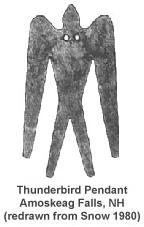
Other sheet metal pendants from around this time include brass bear-claw-shaped pendants, which have been found by archaeologists at Fort Shantok, a 17th century Mohegan village and other places including the upper Connecticut River Valley (Thomas 1979). Copper or brass triangular and roughly rectangular sheet metal pendants have also been found around Ipswich, Massachusetts (Snow 1980: 84-85).
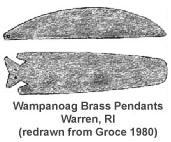 Large pendants found around New England include a copper 'thunderbird' shaped gorget. This large neck ornament, from Amoskeag, New Hampshire, was probably fashioned from a copper kettle Brasser (1978). Two fairly large 17th century Wampanoag sheet brass pendants from Rhode Island were made to represent fish or whales, and were probably also made from worn-out kettles (Groce 1980).
Large pendants found around New England include a copper 'thunderbird' shaped gorget. This large neck ornament, from Amoskeag, New Hampshire, was probably fashioned from a copper kettle Brasser (1978). Two fairly large 17th century Wampanoag sheet brass pendants from Rhode Island were made to represent fish or whales, and were probably also made from worn-out kettles (Groce 1980).
Breastplates were also fashioned from sheet copper, described by Martin Pring at Plymouth in 1603 and by Gosnold on islands off of Massachusetts in 1602 (Rainey 1936) . These breastplates were about a foot long, six inches wide and were worn hung from around the neck.
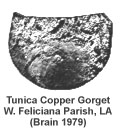

© 1994-1999 Tara Prindle.